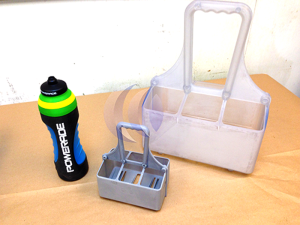Of course, we all acknowledge that the World Cup is made possible by the teams of hardworking athletes who have been training their whole lives for a chance at glory, but, behind the scenes, the real work is done by those oft-overlooked underdogs in the sports universe: the sponsors. And behind every sponsor is a dedicated team striving to carry out the promotional work that will be seen by billions of fans across the globe. In the case of POWERADE, one promotional item could not have been made without the help of 3D printing.

As you might expect, APP relied on 3D printing, specifically using 3D Systems SLA technology, to print a functional prototype. They 3D printed a half-scale model of the carrier in about 9 hours, which was then sent to their customer for approval. Jason Dickman, president of APP, explained the company’s reasons for utilizing stereolithography, “We chose SLA using the iPro 8000 machine to complete this stage for several reasons. First, SLA allows for high precision in the produced parts, with tolerances usually within .005 inches. Second, SLA offers a good mix of speed and accuracy, meaning we could complete the initial concept prototypes quickly and get them approved faster.”
After making the minor changes suggested by Coca-Cola’s marketing executives, APP 3D printed full-scale models of the carrier in Accura 60 resin. The print job, which totaled about 15 hours for 2 parts in each batch, were used as the final check parts and mold masters for the ultimate silicone molding and casting procedures. Dickman continues, “We printed out six mold masters in less than a couple of days, from which silicone molds were created for the production phase of the bottle carriers. We could never have done this kind of turnaround of mold masters with traditional processes. 3D printing totally made the difference with this project.”

In the end APP was able to cast the 300 carrier halves that would be assembled into 150 carriers, performing about 40 to 50 castings per day. Naturally, the carriers were decorated with the POWERADE insignia to be carried by World Cup players, displaying the brand to viewers around the planet. Dickman champions the use of 3D printing for the project, saying, “Because of the accuracy of our initial SLA concept designs, we were able to produce cast urethane parts that needed only minimal post-processing, mostly removing the vents, gates, and flash from the parts. After finishing, the parts were ready to be snapped and screwed together, then decorated, packed, and shipped.” He adds, “Without the fast and accurate 3D printing using 3D Systems’ SLA technology, there would have been no way to get this done within the tight timeline. We managed to pull off an amazing project in no time at all using 3D printing, and the ingenuity of my team was astounding to see.”
So, there you have it: if it weren’t for 3D printing, there’d be no 2014 World Cup. And, no matter who wins this epic tournament, 3D printing has won it for us all.
Source: 3D Systems


